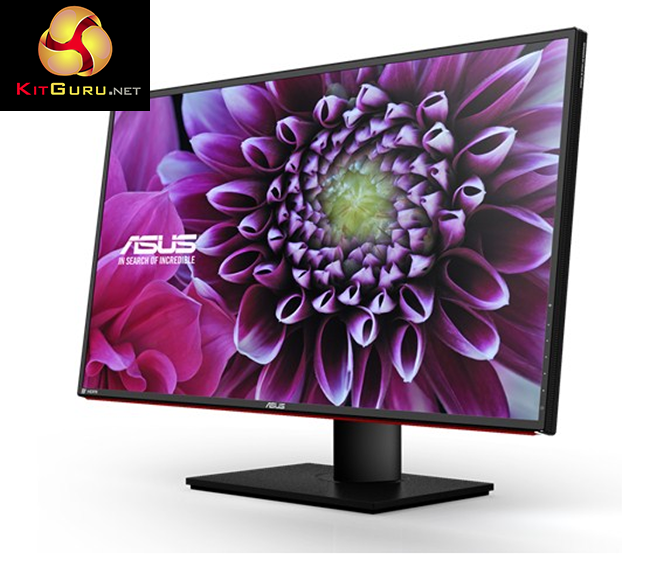The Asus PA328Q ProArt is a very capable monitor and it delivers a well balanced set of results which will appeal to a wide audience.
First impressions are positive, the stand comes preassembled, and it can be attached to the back of the screen without the need for any tools. It can be rotated easily into portrait mode and there is full support for tilt and height adjustment. The stand is heavy and ensures that the large heavy panel doesn't wobble or shake when placed on a flat surface. It may seem like a small point, but many larger screens ship with inadequate stands which can cause issues.
Technically there is a lot to like, panel sharpness rates as excellent out of the box, and most of the default settings are certainly usable. Colour reproduction and saturation are first class and viewing angles are stellar. Refresh response is quick, although being an IPS design mean inherently it does fall short of the best TN panels on the market – a deciding factor if you play games extensively.

For designers and photographers, the PA328Q ProArt will prove invaluable, although as I mentioned earlier in the review I find the Splendid settings to be somewhat vexing. To get the most from the panel, you really do need to have the Uniformity Compensation setting enabled. Some of the Splendid settings disable the ability to use this setting at all. Brightness and Contrast settings are also not universally available, so some attention needs to be paid on initial configuration.
Unfortunately ASUS don't offer a facility for hardware calibration and this will mean that the factory calibrated sRGB mode will go out of sync over the years. There is always the option to buy a third party colorimeter to adjust other modes, however this comes with an additional cost around £150.
All in all, I rate this monitor quite highly, and even with the flaws mentioned earlier in the review, it is capable of delivering a wide, accurate colour gamut and the backlighting is commendable, with Uniformity Compensation enabled.
Availability seems rather scarce right now, although you can find it on Amazon for £1,030.00 inc vat. Some Amazon partners are listing it for as low as £950 inc vat so it is well worth shopping around, especially as availability improves in the coming weeks.
Discuss on our Facebook page, over HERE.
Pros:
- Built to the highest standards.
- class leading UI.
- colour rendition is excellent.
- fast enough for gaming.
- stand implementation is excellent.
- thin bezel.
Cons:
- its not cheap.
- splendid modes can disable some important settings.
- no facility hardware calibration.
Kitguru says: The Asus PA328Q delivers a beautiful, accurate image from the extensive colour palette, making it ideal for a semi pro designer or photographer.

 KitGuru KitGuru.net – Tech News | Hardware News | Hardware Reviews | IOS | Mobile | Gaming | Graphics Cards
KitGuru KitGuru.net – Tech News | Hardware News | Hardware Reviews | IOS | Mobile | Gaming | Graphics Cards



It’s actually only twice the pixel density of a 1080p monitor of the same size.
You’re wrong and here’s why…
32″ is the diagonal measurement so effectively, 27.89″ × 15.69″
= 437.6in² 16:9
1080p = 68.84 PPI
2160p = 137.68 PPI
But wait, that’s only double? Wrong, this is the misinterpretation of pixel
density. If we were strictly talking about a straight line, then yes this would
be correct. However, because we are using a 2d plane for our viewing pleasure
it is in reality like this.
1080p = 4739 PPI²
2160p = 18956 PPI²
That’s right, the pixel density is correctly 4x that of 1080p. =D
The styling looks similar to the ROG Swift, nice! 🙂
◔❧❧◔❧❧◔I RECEIVED FIRST DRAFT OF $13000!@ak6:
,
➨➨➨➨https://QuickerAdvicehina.biz/learner/kits….
2X lineal density
4X areal density
People misunderstand how crucial it is to calculate the correct pixel density and use the linear form since the numbers are smaller making them easier to pick up on. But, we don’t just view screen in a straight line. Also, they’re not equally the same PPI Vertically as they are Horizontally. They differ slightly, but not by much to write home about.
“Factory pre-calibrated, industry-leading color accuracy with 100% sRGB and Rec. 709 color space support.”
its NOT UHD-1 Rec. 2020 real color space compliant so why would any consumer care to spend any money here when UHD-1/UHD-2 have their “basic parameter set” is defined by the “ITU BT.2020 standard” 10bit/12bit real colourspace, and not the antiquated Rec. 709 pseudo color space.
https://tech.ebu.ch/docs/events/webinar049_BeyondHD-update/hoffmann_beyondHD_update.pdf
http://www.bbc.co.uk/rd/blog/2013/06/defining-the-future-of-television
Defining the Future of Television
Posted by Andrew Cotton on 19 June 2013
…For those who’re not familiar with UHDTV its basic parameter set is defined by the ITU BT.2020 standard. The standard defines two UHDTV profiles – what’s commonly called UHD-1 at 3840×2160 pixels and UHD-2 at 7680×4320 pixels. The UHD-2 format was used for last year’s joint NHK/BBC public demonstrations of Super Hi-Vision during the London 2012 Olympics…..
Correct or to put it more simply:
HD 1920 x 1080p = 2,073,600 pixels displayed
UHD 3840 x 2160 = 8,294,400 pixels displayed
UHD is exactly 4 times HD (4 x 2,073,600 = 8,294,400) pixels
Not one of your better reviews guys. There is little mention of the HDMI 2.0 input which is a first on a monitor. Does it support chroma 444 across all inputs at 60hz 4k etc. We need details.